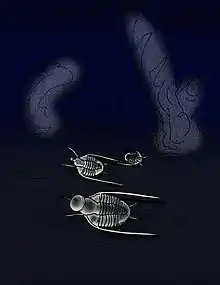Bulbaspis
Bulbaspis ("bulb shield") is a late Ordovician genus of asaphid trilobites of the family Raphiophoridae found primarily in upper Ordovician-aged deepwater marine strata of Kazakhstan, China, and possibly Tasmania. Species of Bulbaspis are similar to other raphiophorids such as Ampyx and Raphiophorus, save that the long spine that emanates from the glabella of the latter two genera has been modified into a knob-like or bulb-like structure in Bulbaspis that developed incrementally in the animal's growth.[1] The function of the bulb is currently unknown: one hypothesis suggests sexual selection may have had a role in its evolution in the genus.[2]

Individuals of B. brevis, demonstrating development of the bulb
| Bulbaspis Temporal range: | |
|---|---|
 | |
| B. mirabilis | |
| Scientific classification | |
| Domain: | Eukaryota |
| Kingdom: | Animalia |
| Phylum: | Arthropoda |
| Class: | †Trilobita |
| Order: | †Asaphida |
| Family: | †Raphiophoridae |
| Genus: | †Bulbaspis Chugaeva, 1956 |
| Type species | |
| Ampyx bulbifer Weber, 1932 | |
| Species groups[1] | |
|
See text | |
Species
- ovulum group
- B. lageniformis Zhou et al. 1982
- B. ovulum Weber 1948
- B. ordosensis Lu et al. 1976
- bulbifer group
- B. brevis Zhou & Zhou, 2006
- B. bulbifer (Weber, 1932)
- B. korlaensis Zhang, 1981
- B. mirabilis Chugaeva, 1958
- B. sphaerornatus Chugaeva, 1958
See also
References
- Zhiqiang, Zhou, and Zhou Zhiyi. "Late Ordovician trilobites from the Zhusilenghaierhan area, Ejin Banner, western Inner Mongolia, China."MEMOIR-ASSOCIATION OF AUSTRALASIAN PALAEONTOLOGISTS 32 (2006): 383. "Archived copy" (PDF). Archived from the original (PDF) on 2016-05-13. Retrieved 2016-01-12.
{{cite web}}: CS1 maint: archived copy as title (link) - Knell, Robert J., and Richard A. Fortey. "Trilobite spines and beetle horns: sexual selection in the Palaeozoic?." Biology letters 1.2 (2005): 196-199.
This article is issued from Wikipedia. The text is licensed under Creative Commons - Attribution - Sharealike. Additional terms may apply for the media files.